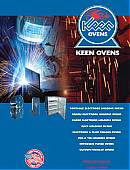Industrial Ovens
Front-Loading
![]() Under 10 cubic feet
Under 10 cubic feet
![]() 10-20 cubic feet
10-20 cubic feet
![]() Over 20 cubic feet
Over 20 cubic feet
![]() See All
See All
Top-Loading
![]() Under 10 cubic feet
Under 10 cubic feet
![]() 10-20 cubic feet
10-20 cubic feet
![]() Over 20 cubic feet
Over 20 cubic feet
![]() See All
See All
Learn About Our Industrial Ovens
Welding Ovens
![]() Stick Electrodes
Stick Electrodes
![]() Sub-Arc Flux
Sub-Arc Flux
![]() Wire Spools
Wire Spools
![]() Tig Filler Wire
Tig Filler Wire
![]() Multi-Purpose
Multi-Purpose
![]() Nitrogen Purge
Nitrogen Purge
![]() See All
See All
 Order Our Free Catalog Today Click Here |
| Available Inventory |
Don't Make the Welding Inspector Mad!I remember working for a foreman who was about as cocky and arrogant as they come. He treated just about everyone he met with disdain. He'd just been promoted to foreman and was trying to be a tough guy. We were working on a pretty tall high-rise, his first "big job." That's where "Mr. Tough Guy" learned real quickly that you do NOT act cocky and disdainful to a welding inspector! Welding inspectors usually have quite a few jobs going at once meaning they stay BUSY! Inspectors will stop in a lot of times unexpectedly to check out welds on the structures, and we had been going along fine for the first few floors with all our welds passing. Welding inspectors use destructive and non-destructive methods of testing to make sure the welds are sound. "See below." The most widely used test in the shop and field is the visual test which every good welder should do to each and every weld they make. Once an inspector is familiar with a welder, they'll usually randomly check various welds visually to make sure the welds are in compliance with the specifications for the job. (WPS - or welding procedure specifications.) Our not-so-wise boss was in a bad mood and decided to take it out on the weld inspector one day. He told the inspector he needed to hurry up and get out of our way the same way a drill sergeant would tell a new recruit to get down and do pushups! The inspector didn't say a word; he just nodded and walked off. The next morning when we got to the job there was a sea of red all over the floor we were working on. Red tags stated the welds were to be gouged out and re-done. It wasn't that the welds were bad; they just were "technically" not up to specifications. Our welding inspector was not a happy camper. Our tough guy boss was almost in tears! Luckily for
us, we were able to talk to the inspector and explain what an idiot our boss was
and that he was not speaking for our crew. The inspector politely told us that
we better keep that no good blankety-blank away from him or next time he'd shut
the whole job down! He then took back his cards, cussed us again, and left. Did
that foreman learn from that job? Don't know because that was the LAST time I
ever worked for that guy!
Defects are found by two types of tests. Non-destructive:
Non-destructive are used on structures because it would not be practical to cut out a piece of beam on a building, or a column on an underwater oil derrick for a destructive test. Destructive:
Destructive are
usually used in educational testing, shop testing, and tests welders take to get
certified or hired on at a jobsite. |